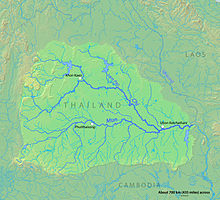Chi River
| Chi River | |
|---|---|
 Chi River in December 2020 bordering betweenYasothonandRoi Et province | |
 Map of the Mun River watershed showing the Chi River | |
| Native name | Mae Si(Thai) |
| Physical characteristics | |
| Source | |
| • location | Chaiyaphum |
| Mouth | |
• location | Mun river,Sisaket Province |
• elevation | 110 m (360 ft) |
| Length | 765 km (475 mi) |
| Basin size | 49,480 km2(19,100 sq mi) |
| Discharge | |
| • location | Yasothon |
| • average | 290 m3/s (10,000 cu ft/s) |
| • maximum | 3,960 m3/s (140,000 cu ft/s) |
TheChi River(Thai:แม่น้ำชี,RTGS:Maenam Chi,pronounced[mɛ̂ː.náːmtɕʰīː];Northeastern Thai:แม่น้ำซี,pronounced[mɛ̄ː.nâːmsi᷇ː]) is the longestriverflowing wholly withinThailand.It is 765 kilometres (475 mi) long but carries less water than the second longest river, theMun.The name of the river is "Mae Si" ([sīː]) in theIsanandLao languagesof the region, being transliterated as "Chi" in Bangkok-Thai. Inwet seasonsthere are oftenflash floodsin thefloodplainof the Chi River basin.[1]
Course
[edit]The river rises in thePhetchabun mountains,then runs east through the central Isan provinces ofChaiyaphum,Khon Kaen,andMaha Sarakham,then turns south inRoi Et,runs throughYasothonand joins the Mun in theKanthararom districtofSisaket Province.The river carries approximately 9.3 cubic kilometres (2.2 cu mi) of water per annum.[2]
The river was an 18th-century migration route for the re-peopling of theKhorat Plateauby ethnicLao peoplefrom the left (east) bank of theMekongresettling on the right bank. This began in 1718 when the first king of the left bankKingdom of Champasak,KingNokasad,sent a group of some 3,000 subjects led by an official in his service to found the first settlement in the Chi River valley—and indeed anywhere in the interior of theKhorat Plateau—MuangSuwannaphumin present-dayRoi Et Province[3](a history recorded and remembered, largely in terms of the struggle to expandwet-rice cultivationin the river valley). Their descendants are now regarded as a separateethnic groupfrom the Lao to the north and the central Thai to the southwest.[citation needed]
Pop culture
[edit]Chi river is the setting of aThai TV dramaonChannel 7 HD,titledChart Lam Chi(ชาติลำชี; The River Chi's Protector). It was an action-drama TV series that aired from March 14 to April 25, 2018,remakefrom namesakefilmin 1969 (starred byMitr ChaibanchaandPetchara Chaowarat).[4]
References
[edit]- ^Water level in Chi River still high
- ^Delineation of flood hazards and risk mapping in the Chi River Basin
- ^Charles F. Keyes (1976)."In Search of Land: Village Formation in the Central Chi River Valley, Northeastern Thailand".In Brow, James (ed.).Contributions to Asian studies.Vol. 9: Population, Land and Structural Change in Sri Lanka and Thailand. Leiden: Brill. p. 47.ISBN90-04-04529-5.
- ^"เรื่องย่อชาติลำชี"[Chart Lam Chi's synopsis].Ch 7 HD(in Thai).
Further reading
[edit]- C. Pawattana; N. K. Tripathi; S. Weesakul (2007)."Floodwater retention planning using GIS and hydrodynamic model: a case study for the Chi River Basin, Thailand".Environmental Informatics Archives.5.ISEIS – International Society for Environmental Information Sciences: 548–556. EIA07-056.RetrievedMarch 5,2012.[permanent dead link]
- Choopug Suttisa (2011)."Civil Society in the Chi River, Northeast Thailand"(PDF).Massey University,New Zealand. pp. 1–17. Archived fromthe original(Ph.D.)on April 26, 2012.RetrievedMarch 5,2012.
Abstract:This paper aims to examine the concept of civil society in the rural communities in the Chi River, Northeast Thailand. It focuses on the questions of what civil society means in the Thai rural context, what factors make civil society proactive and how civil society is activated. By using participatory action research (PAR) as the main methodology to answer the inquiries. The paper addresses the new term of 'grounded civil society' which was created through the research process in two case studies. The research determines that two elements activated grounded civil society are from outside and inside factors. The outside factors included the negative effect of government development projects and the intervention of the participatory action research, which stimulate local people to engage in civil society. The inside factors are the poor economic conditions of the villagers and the social capital existing in the communities. The paper concludes with an analysis of the causal links between social capital and civil society which claims that social capital facilitated the creation of civil society.
External links
[edit]16°13′N103°37′E/ 16.21°N 103.62°E
